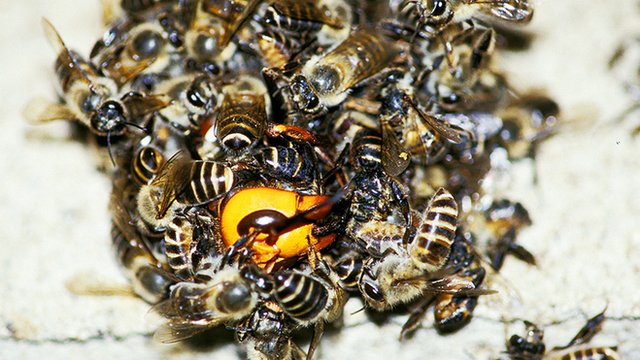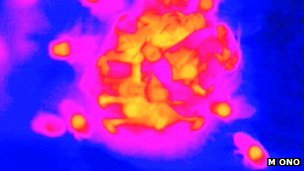Hornet Killing Honey-Bees’ Brain Activity Measured
 |
| Bees gather around a hornet inserted into their hive. Footage courtesy of Masato Ono, Tamagawa University. |
Japanese honeybees' response to a hive-invading giant hornet is efficient and dramatic; they form a "bee ball" around it, serving to cook and asphyxiate it.
Now, researchers in Japan have measured the brain activity of honeybees when they form this killer ball.
One highly active area of the bees' brains, they believe, allows them to generate the constant heat which is deadly for the hornet.
The team published their findings in the open-access journal, PLoS One.
Prof Takeo Kubo from the University of Tokyo explained that "higher centres" of the bee's brain, known as the mushroom bodies, were more active in the brains of Japanese honeybees when they were a part of the "hot defensive bee ball".
To find this out, the team lured the bees to form their ball by attaching a hornet to the end of a wire and inserting the predator into the hive.
This simulated invasion caused the bees to swarm around the hornet. The researchers then plucked a few of the bees from the ball and measured, throughout each of their tiny brains, the relative amount of a chemical that is known to be a "marker" of brain activity.
"We found that similar [brain] activity is evoked when the Japanese honeybees are simply exposed to high temperature (46C) in the laboratory," the researcher told BBC Nature.
 |
Honeybees' brain activity may help them maintain the 46C temperature on the inside of the ball |
This suggests that this area of the brain is important for processing temperature information.
The team thinks that the mushroom bodies allow the bees to precisely control the temperature they generate inside the bee ball. The same researchers previously discovered that this remains at 46C until the hornet is successfully killed.
Prof Kubo said that this brain region might "modulate the vibration of the flight muscle", which is what generates this heat.
The bees, he explained, must maintain the temperature in the bee ball around 46 degrees "because, if the temperature of the bee ball is below [that], the hornet will not be killed".
"[And] if the temperature is above 46 degrees, not only the hornet but also the bees will be killed."
Dr Masato Ono from Tamagawa University, who also took part in the study, added: "The crucial function is to keep temperature inside the bee ball within the range of 46 to 48C, [like] a thermostat."
The team hope eventually to find out what kind of brain function is unique to the Japanese honeybees compared to that of the European honeybees, which do not form these spherical armies.
www.bbc.co.uk/nature/17381710?print=true